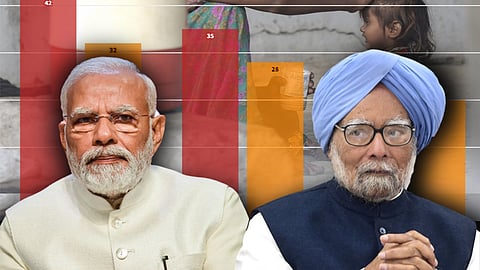

In October 2023, a comment made by Union Minister of Women and Child Development Smriti Irani came under severe criticism. Smriti had ridiculed the credibility of the Global Hunger Index (GHI)-2023 report that ranked India 111th among 125 countries. In response, Congress president Mallikarjun Kharge said, “The Modi government is allergic to any critical global data, but even Indian data says that our people are going hungry!” The Indian data he cited was from the latest National Family Health Survey (NFHS-5) for 2019-21.
Unlike the Global Hunger Index, which is measured by European non-profits, the NFHS is carried out under the Government of India’s Ministry of Health and Family Welfare. Five rounds of the survey have been published since 1992-93, and the last three editions happen to roughly overlap with the transfer of power at the Union government. A comparison between the indicators of health, education, and quality of life can be a helpful proxy for comparing progress on various fronts, under the previous UPA government led by Manmohan Singh (2004-2014) and the present NDA government under Prime Minister Narendra Modi (2014-2024).
While NFHS-6 (2023-24) is yet to be published, in July 2023 the Union government suspended KS James, the director of the International Institute for Population Sciences, the organisation responsible for carrying out the NFHS. James had headed IIPS since October 2018. At the time, reports suggested that James was removed because the government was unhappy with the data that surfaced from these surveys.
We looked at the data from NFHS-3 (2005-06), NFHS-4 (2015-16), and NFHS-5 (2019-21). While NFHS-5 captured data on a total of 131 indicators, this story looks particularly at indicators linked to government interventions such as access to healthcare, nutrition, vaccination, girls’ education, child health, access to clean fuel and electricity, financial inclusion etc. Of the 29 indicators we compared, in 17 aspects, UPA performed better than NDA.
This includes controlling anaemia, delivery care for women, health insurance, access to LPG, and women’s education and financial inclusion. Though the NDA performed better in improving access to drinking water, sanitation, etc., the data doesn’t always match the BJP’s impressive claims.